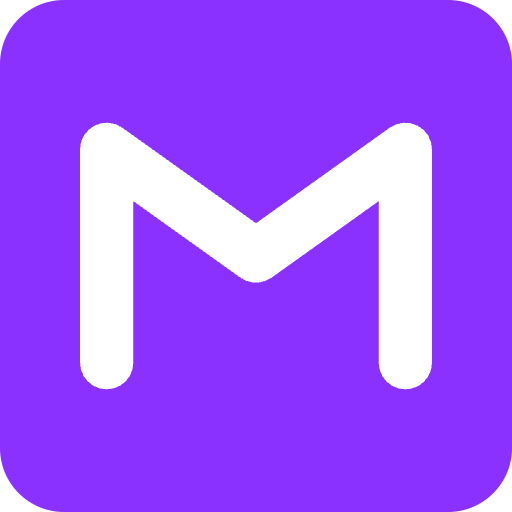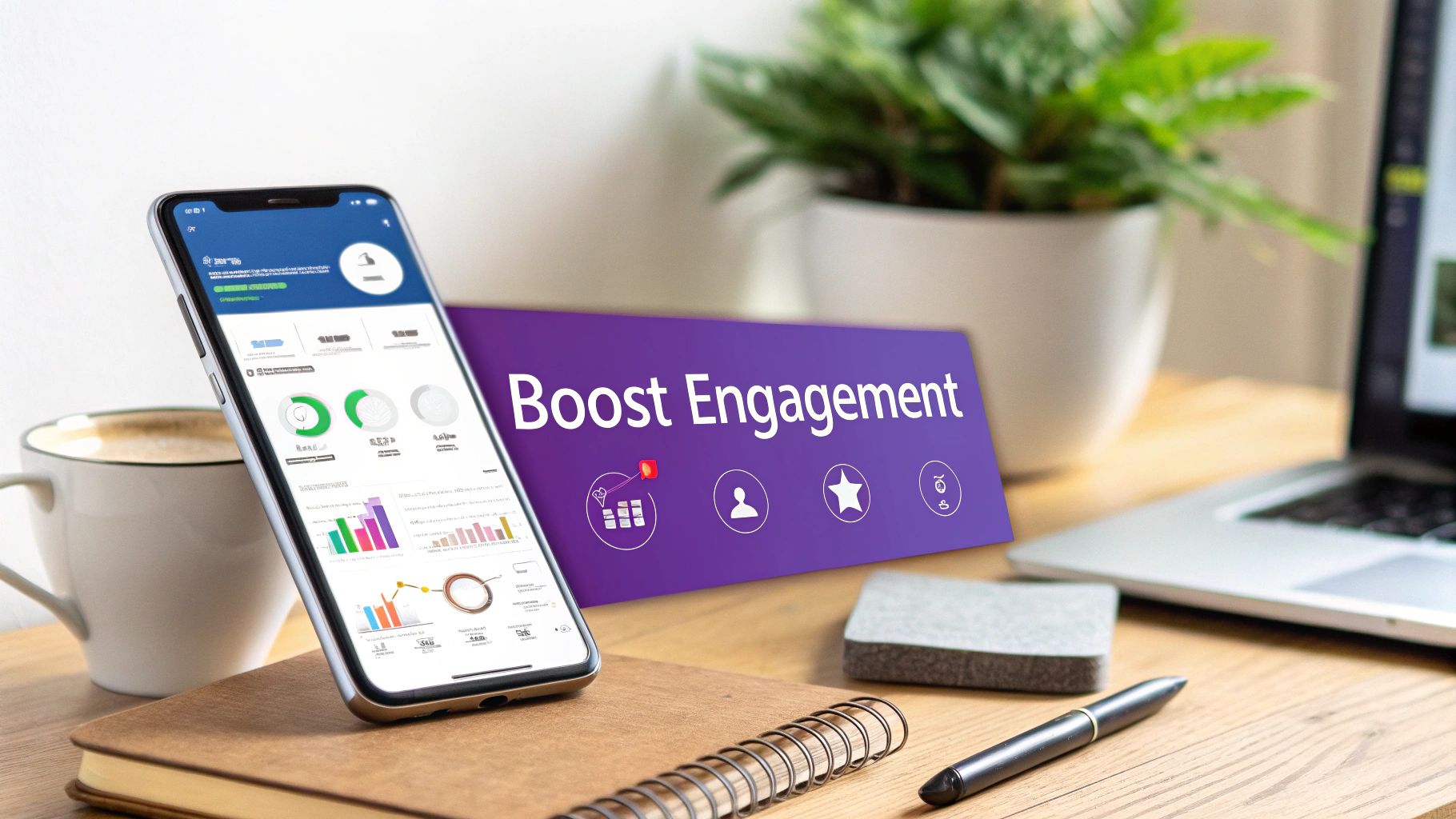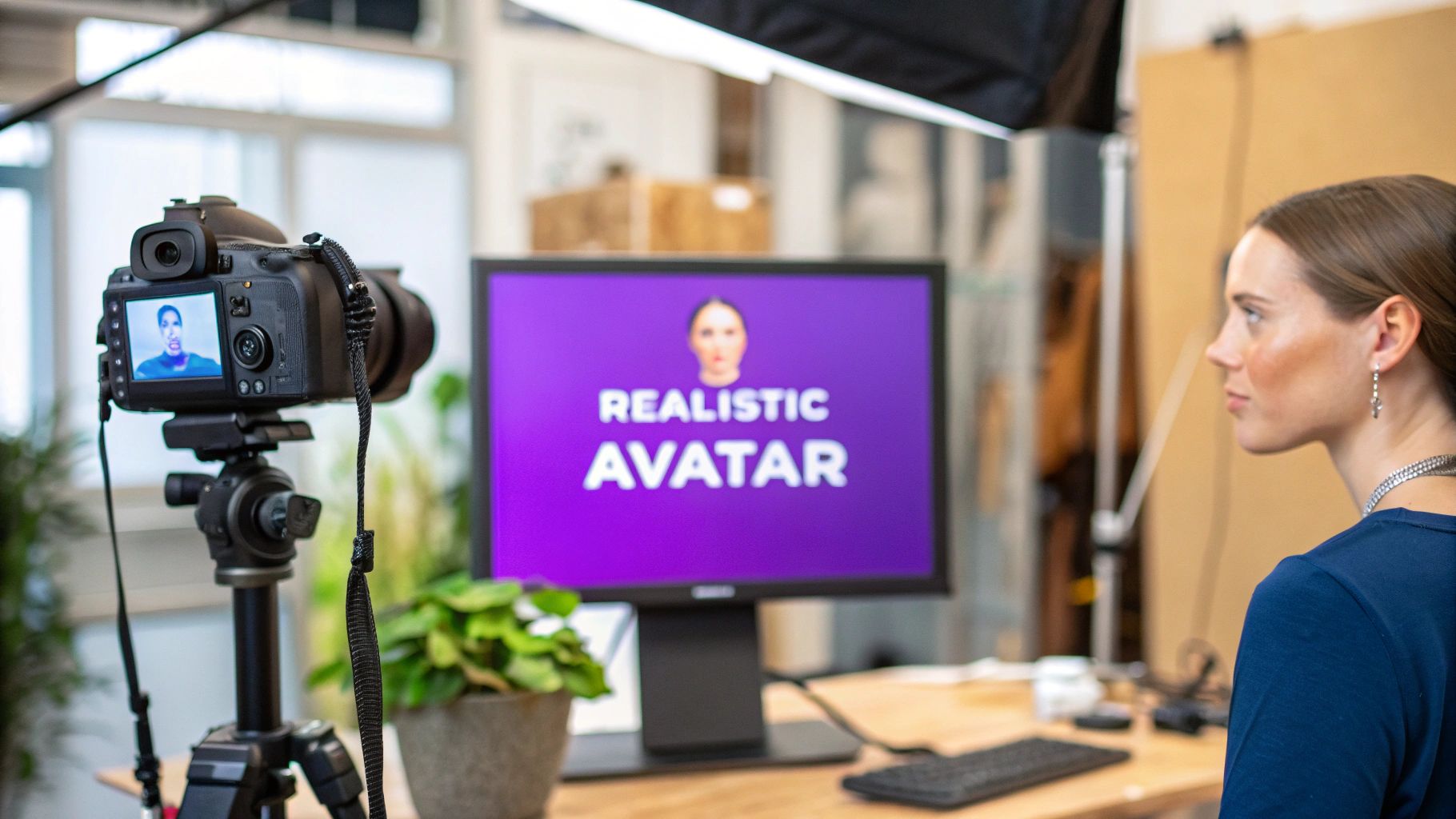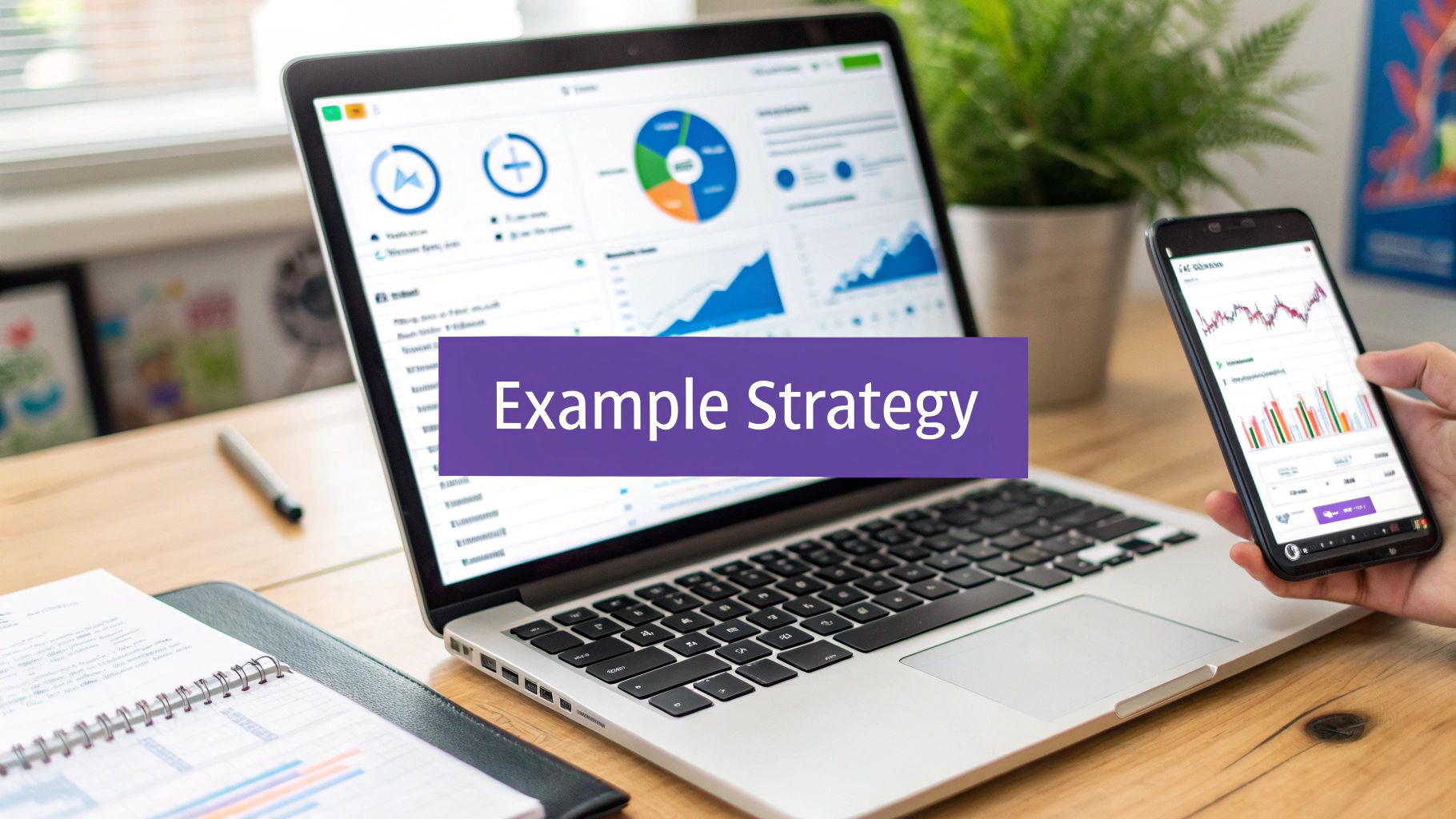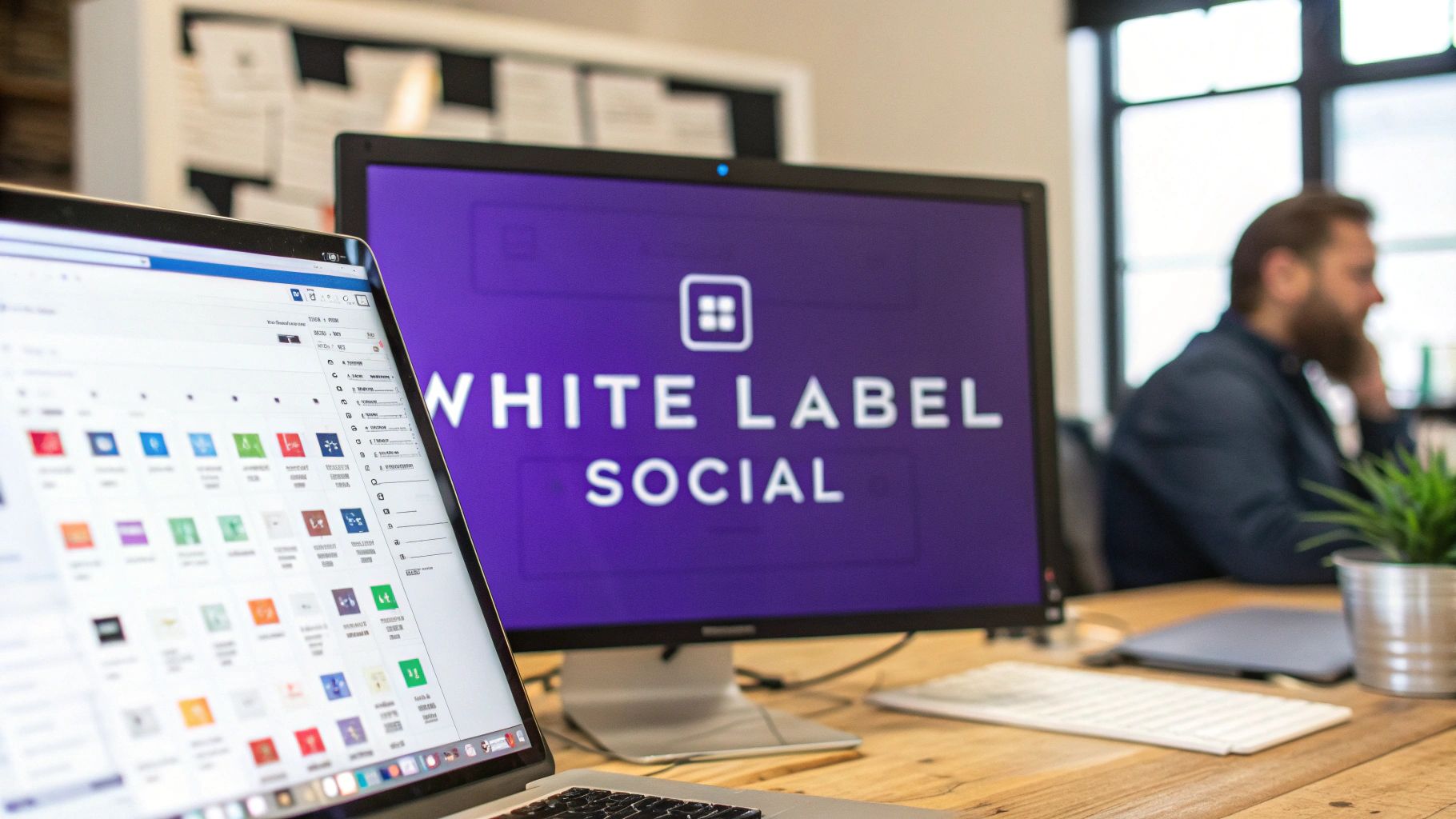The 7 Best Times to Post on Social Media for 2025
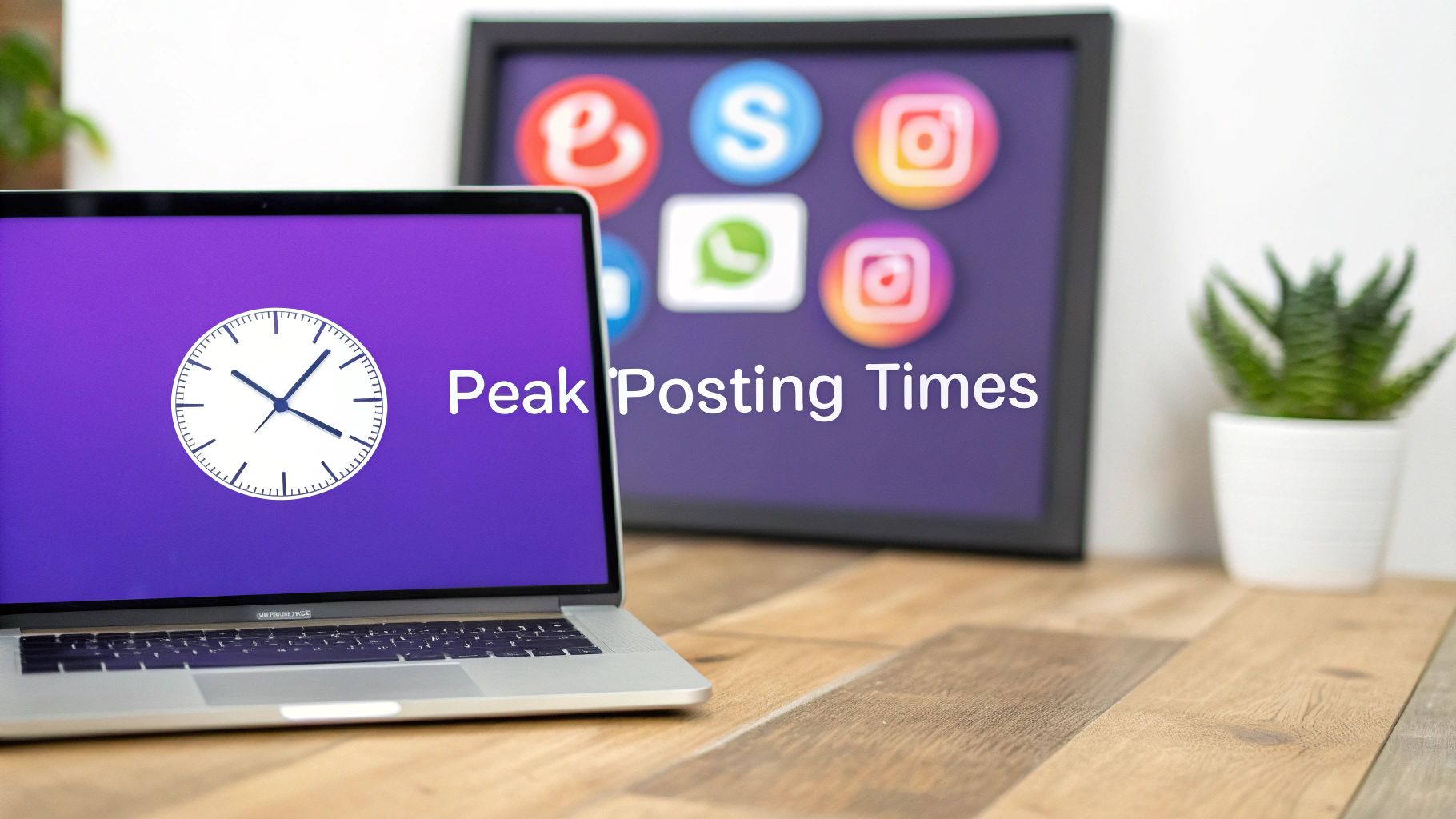
In the crowded world of social media, great content is only half the battle. The other half is ensuring your audience actually sees it. Posting at the right time can mean the difference between a post that soars with engagement and one that sinks without a trace, algorithmically buried before it has a chance. While a single, universal 'best time' is a myth, understanding peak user activity windows is a critical first step toward maximizing your impact.
This guide moves beyond generic advice to provide a strategic framework for finding the best times to post on social media for your specific brand and platform. We will dissect seven data-backed time slots, explaining the user behaviors that make them effective. By understanding the 'why' behind the 'when', you can make more intelligent scheduling decisions.
Here, you will learn how to:
- Identify high-engagement windows across different platforms like Instagram, LinkedIn, and TikTok.
- Align your posting schedule with your audience's daily routines, from their morning coffee scroll to their evening wind-down.
- Move beyond general time slots by leveraging your own analytics for hyper-specific timing.
Whether you're a B2B marketer on LinkedIn or a consumer brand on Instagram, these insights will help you boost your reach and turn timing into a tangible business advantage. We will explore specific, actionable strategies backed by industry research from leaders like Sprout Social and HubSpot. Let’s dive into the key windows that will get your content in front of the right people at the right moment.
1. Morning Coffee Hours (6-9 AM)
One of the most consistently powerful windows for social media engagement is the early morning, specifically between 6 AM and 9 AM. This period aligns with a universal daily ritual: people waking up, reaching for their phones, and scrolling through feeds before their day truly begins. It's a time of fresh attention, where your content can be the first thing your audience sees, setting the tone for their day and capturing engagement before the daily noise fully kicks in.
This timeframe capitalizes on the "first check" phenomenon. Whether someone is still in bed, sipping their first coffee, or on their morning commute, their mind is relatively uncluttered. This makes them more receptive to new information, which is a key reason why understanding the best times to post on social media often starts with an early morning strategy. The content you post here has a higher chance of being absorbed rather than just scrolled past.
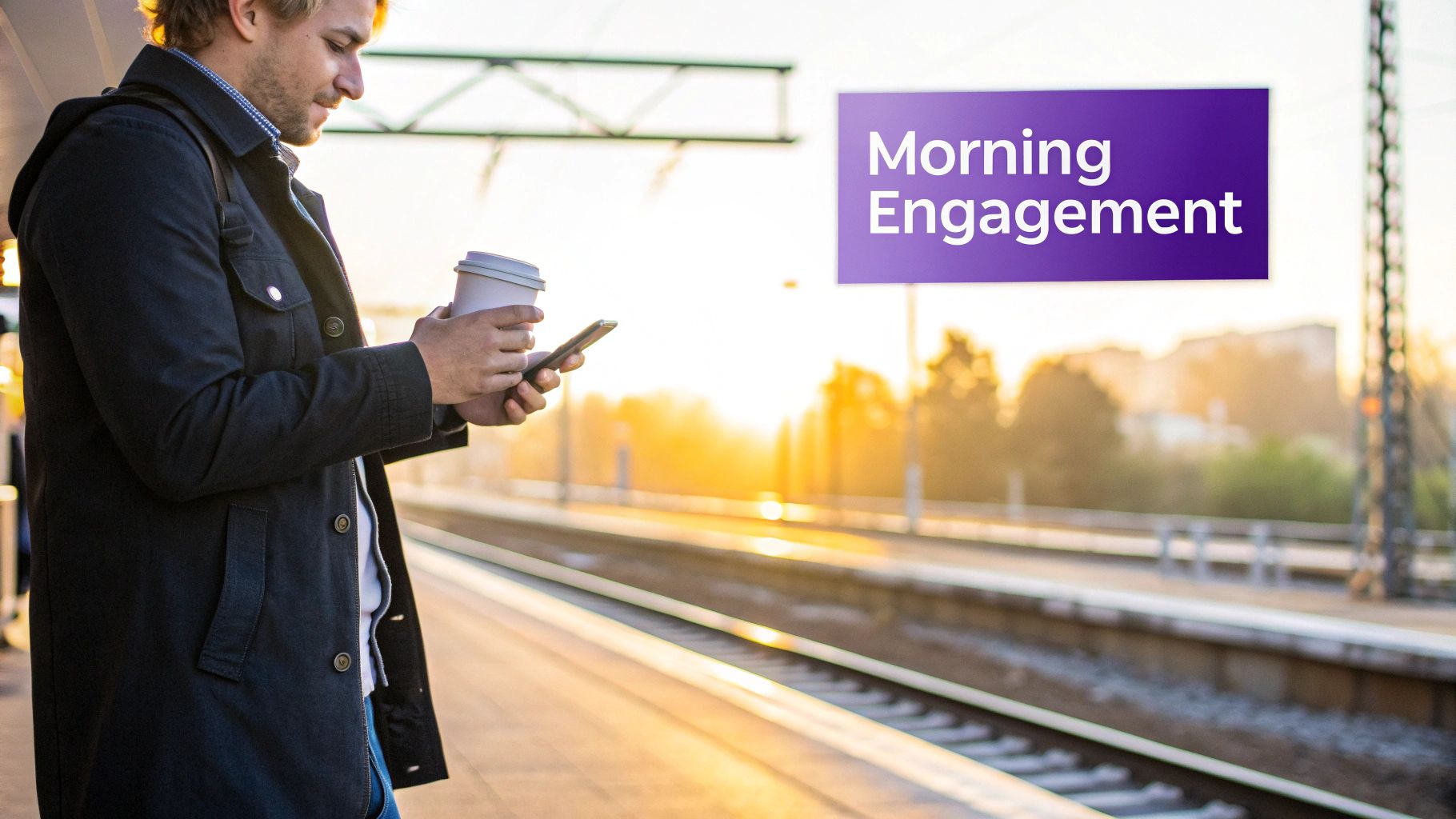
Why This Window is So Effective
The power of the Morning Coffee Hours has been validated by numerous studies and industry leaders. Research teams at Sprout Social and analytics from Buffer consistently highlight these hours as peak engagement periods across multiple platforms. This isn't just theory; it's backed by tangible results. For instance, major news outlets like CNN frequently see their highest social traffic and engagement between 7 AM and 9 AM as users look for daily headlines.
Similarly, in the B2B space, this window is golden. HubSpot marketing strategists have pointed to the morning as a prime time for professional content. Microsoft, for example, has reported achieving up to 40% higher engagement on LinkedIn posts published around 8 AM. B2B SaaS companies have also noted a significant lift, with some reporting a 25% increase in lead generation from content shared during these early hours, as decision-makers review industry news before their meetings start.
Expert Insight: "The first hour of the workday is often dedicated to catching up. Your content, if timed correctly, becomes part of that essential morning brief for professionals, positioning your brand as a timely and relevant resource."
Actionable Tips for Morning Posts
To make the most of this prime-time slot, a targeted approach is crucial. Simply posting is not enough; you must align your content with your audience's morning mindset.
- Schedule for Your Audience's Time Zone: Don't post at 7 AM in your own time zone if your target audience is three hours behind. Use scheduling tools like Buffer, Hootsuite, or Later to ensure your content goes live precisely between 7 AM and 8 AM in your primary audience's location.
- Align Content with the Morning Mindset: For B2B audiences on platforms like LinkedIn or X (formerly Twitter), focus on educational, insightful, or professional content. Think industry news, quick tips, or motivational quotes. For B2C platforms like Instagram or Facebook, inspirational content, quick news updates, or behind-the-scenes glimpses work well.
- Test and Refine: The 6 AM to 9 AM window is broad. Use your platform’s native analytics to test specific times. Post at 7:15 AM one week, 7:45 AM the next, and 8:30 AM after that. Track your reach, likes, comments, and shares to identify the absolute sweet spot for your unique followers.
2. Lunch Break Window (12-2 PM)
Another highly effective time slot for social media engagement is the midday lunch break, typically falling between 12 PM and 2 PM. This window represents a natural pause in the workday, where professionals and students alike step away from their primary tasks and turn to their phones for a mental break. It's a prime opportunity to capture attention with content that is entertaining, light, and easily consumable.
This period taps into the "midday scroll" habit. After a morning of focused work, users are looking for a quick escape, a dose of entertainment, or a way to catch up on personal interests. Your content can serve as that perfect interlude. Understanding the best times to post on social media involves recognizing these daily behavioral shifts, and the lunch break is a predictable and valuable peak. Content published here faces less competition for deep, analytical thought and more openness to immediate engagement.
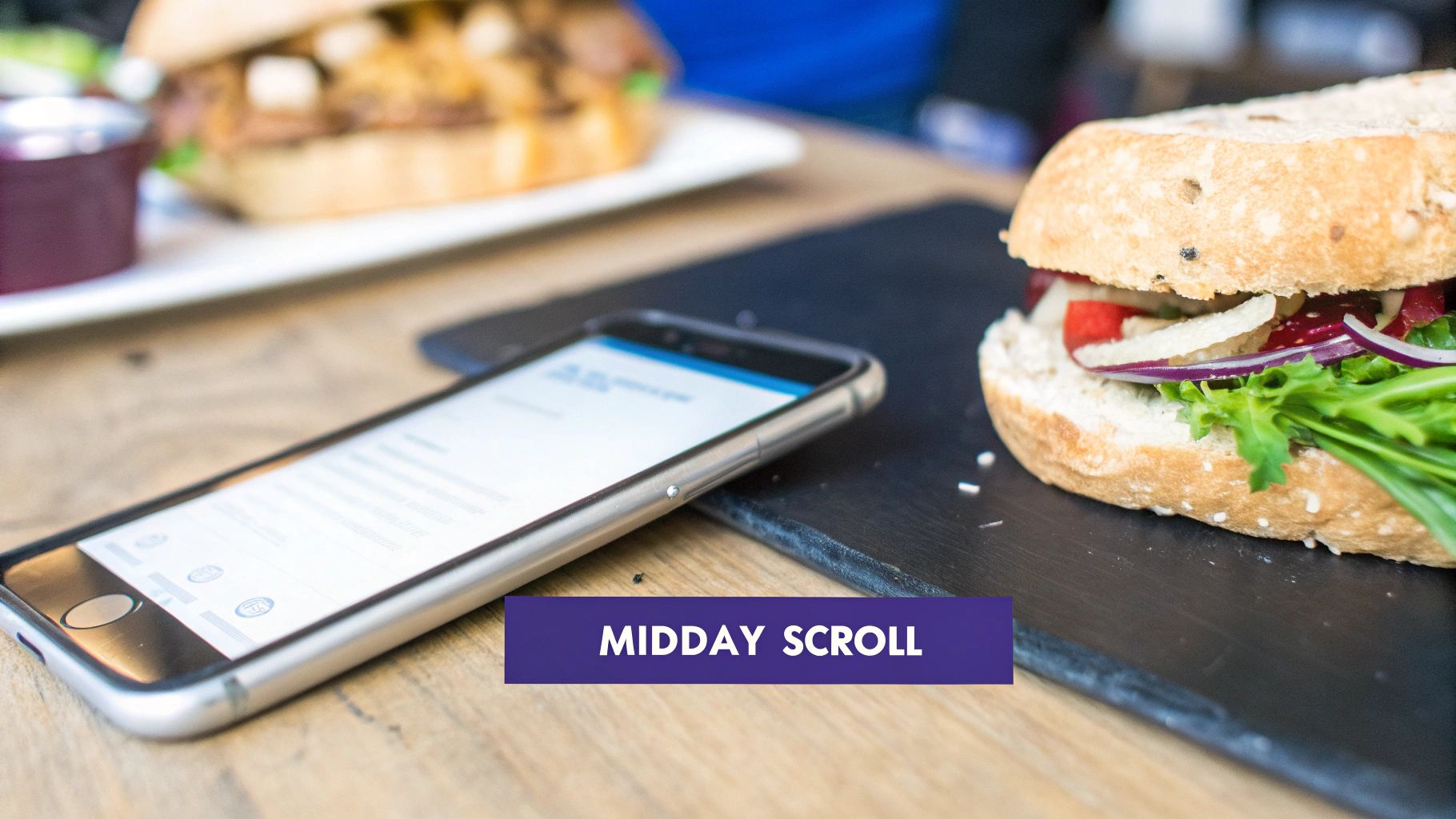
Why This Window is So Effective
The value of the Lunch Break Window is consistently reinforced by data from social media management platforms and successful brand campaigns. Research from the Hootsuite research division and analytics from the team at Later.com frequently identify noon as a high-engagement period, especially for B2C brands on platforms like Instagram and Facebook. This is not a coincidence; it's a direct reflection of user behavior.
The proof is in the performance of major brands. Chipotle, for instance, has demonstrated how to master this window, often seeing 2x higher engagement on Instagram posts shared during lunchtime as users think about their next meal. Similarly, BuzzFeed built a significant part of its viral content strategy around a 12 PM to 1 PM posting schedule, delivering listicles and quizzes perfectly suited for a quick break. Food Network also reports achieving peak video views during these hours, as people look for recipes and food-related entertainment.
Expert Insight: "Lunchtime is a content sweet spot. Users aren't looking for heavy, thought-provoking articles. They want a quick hit of dopamine, a laugh, or something visually appealing. If your content can deliver that in 60 seconds, you'll win the midday scroll."
Actionable Tips for Lunch Break Posts
To capitalize on this midday rush, your content strategy needs to align with the audience's state of mind. It’s about providing a delightful and brief distraction from the workday.
- Keep Content Light and Digestible: This is not the time for dense case studies or complex industry reports. Focus on light-hearted, entertaining, and easily scannable content. Think memes, quick tips, user-generated content features, or fun polls and quizzes.
- Use Eye-Catching Visuals and Short Videos: During a quick scroll, strong visuals are essential to stop the thumb. Use vibrant images, short-form videos like Reels or TikToks, and engaging graphics. Content that can be understood and appreciated in under a minute performs best.
- Post Consistently Monday Through Friday: The workday lunch break is a consistent routine for a large portion of your audience. Maintain a regular posting schedule during this window from Monday to Friday to build anticipation and make your content a regular part of their midday break.
3. Evening Wind-Down (6-8 PM)
As the workday concludes, another powerful window for social media engagement opens up: the evening wind-down, typically between 6 PM and 8 PM. This period captures your audience as they transition from their professional lives to their personal time. It’s when people are commuting home, preparing dinner, or relaxing on the couch, and they turn to social media for entertainment, connection, and leisurely browsing.
This timeframe capitalizes on a shift in user mindset from productivity to relaxation. Unlike the quick morning scroll, evening engagement is often deeper and more prolonged. Users have more time to watch videos, read longer captions, and interact with content, making it a critical slot for brands looking to build community and drive meaningful conversations. Understanding the best times to post on social media must include a strategy for this high-leisure period, as it offers a chance for more immersive content to shine.
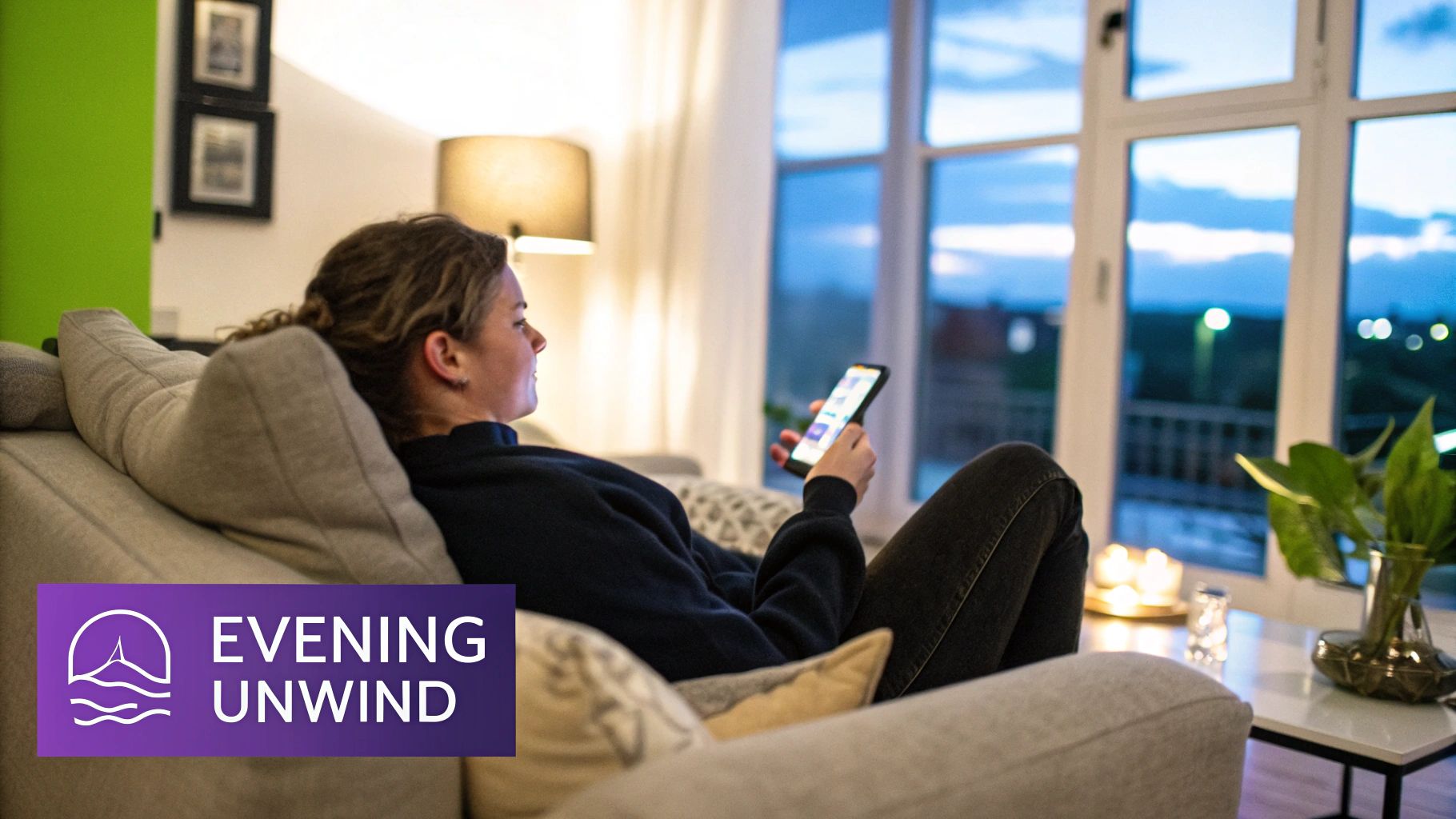
Why This Window is So Effective
The strength of the evening wind-down is rooted in human behavior and has been well-documented by industry research. Data from the Socialbakers (now Emplifi) research team and insights from Instagram for Business consistently point to these hours as a peak time for user activity, especially on visual and entertainment-focused platforms. This is when users are most receptive to content that helps them unwind and connect.
Real-world examples prove its value. Streaming giant Netflix frequently achieves peak engagement for new show trailers and promotional content right around 7 PM, aligning perfectly with when viewers decide what to watch. Nike has also found that its Instagram Stories and Reels perform best between 6 PM and 8 PM, capturing the attention of its audience as they finish their day. In the local business sphere, restaurants often see the highest click-through rates on reservation links and special offers from posts published during these hours, directly influencing evening plans.
Expert Insight: "The evening is when users shift from consuming information to seeking entertainment and connection. Your content becomes part of their relaxation ritual, creating a much stronger emotional bond than a quick glance during a busy workday."
Actionable Tips for Evening Posts
To leverage this high-engagement window, your content needs to match the relaxed, personal tone of the evening. It’s less about professional updates and more about building a relationship.
- Focus on High-Quality, Interactive Content: This is the prime time for visually rich media. Post high-resolution photos, compelling videos, and content that encourages interaction, like polls, quizzes, or open-ended questions. Use Instagram Stories and Facebook Live to create a sense of immediacy and community.
- Post Consistently Monday Through Thursday: While weekends are strong, the 6 PM to 8 PM slot from Monday to Thursday often yields the most consistent results, as routines are more predictable. Test these days to see which performs best for your specific audience.
- Tailor Content to Evening Activities: Create content that aligns with what your audience is doing. A food brand could share a quick dinner recipe. A B2C e-commerce store could showcase user-generated content, or a wellness brand could post a relaxing nighttime routine.
- Consider Commute Patterns: For audiences in major metropolitan areas, the 6 PM hour might still be part of their commute. During this time, audio-friendly content like short videos with clear captions or engaging podcasts can be particularly effective.
4. Weekend Prime Time (1-3 PM Saturday/Sunday)
While weekdays are dominated by structured routines, the weekend offers a distinct and highly valuable window for social media engagement. The period between 1 PM and 3 PM on Saturdays and Sundays represents a prime opportunity, aligning perfectly with relaxed leisure browsing when users have more free time and are in a receptive, unhurried state of mind.
This timeframe capitalizes on post-lunch downtime and pre-evening relaxation. Users are often unwinding, seeking inspiration, or catching up on personal interests, leading to longer session durations and deeper engagement. Understanding the best times to post on social media means recognizing these shifts in audience behavior. Content published during this weekend peak has a greater chance of being savored, shared, and acted upon, rather than being quickly dismissed amidst weekday distractions.
Why This Window is So Effective
The power of the weekend afternoon is particularly potent for visual and lifestyle-oriented platforms. The Pinterest for Business team has consistently highlighted weekend afternoons as a core period for engagement, noting that users are actively planning projects, meals, and purchases. This is supported by data showing that some verticals see up to a 40% increase in saves for Pins posted on Saturday and Sunday afternoons.
This trend is not limited to Pinterest. Home improvement brands like Home Depot have identified Saturdays between 2 PM and 3 PM as a peak engagement time for DIY project inspiration. Likewise, travel influencers and brands often report their highest engagement rates on Sunday afternoons, as followers dream about and plan future trips. This is a time of aspiration and consumption, making it ideal for B2C brands whose products or services align with personal interests, hobbies, and lifestyle goals.
Expert Insight: "Weekends are when consumers transition from a professional mindset to a personal one. Your content should mirror that shift. Instead of focusing on problems and solutions, focus on aspirations, entertainment, and personal fulfillment to connect authentically."
Actionable Tips for Weekend Posts
To successfully capture the weekend audience, your content strategy must adapt to their more relaxed and personal mindset. Overtly corporate or high-pressure messaging will likely fall flat.
- Focus on Aspirational and Lifestyle Content: This is the perfect time for high-quality visuals, storytelling, and inspirational content. Think home decor ideas, travel destinations, recipes, fashion lookbooks, or behind-the-scenes content that builds a personal connection with your brand.
- Encourage Community Interaction: The relaxed nature of weekend browsing makes it an ideal time for engagement-focused posts. Run polls, ask open-ended questions, and launch user-generated content (UGC) campaigns. Encourage followers to share their own weekend projects or experiences using a branded hashtag.
- Avoid the Hard Sell: While the ultimate goal may be a sale, weekend content performs best when it is less promotional. Instead of a direct "Buy Now" message, try a softer approach like "Get inspired for your next project" or "Dreaming of your next getaway?" Link to lookbooks, blog posts, or idea galleries rather than directly to product pages.
5. Tuesday-Thursday Sweet Spot (10 AM - 3 PM)
While specific daily windows are powerful, one of the most reliable strategies for sustained engagement is focusing on the mid-week, mid-day sweet spot. The period from Tuesday to Thursday, between 10 AM and 3 PM, represents the heart of the workweek, where online activity is at its most consistent and predictable. This window avoids the Monday morning rush and the Friday afternoon wind-down, capturing your audience when they are settled in and most active professionally.
This timeframe is the backbone of many successful social media strategies because it aligns with peak productivity and online presence. Professionals are at their desks, taking short breaks to scroll through feeds, researching solutions, and engaging with industry content. This makes it a golden opportunity for B2B brands and any business aiming to establish authority. Understanding the best times to post on social media means recognizing these periods of stable, high-intent activity.
Why This Window is So Effective
The effectiveness of the mid-week sweet spot is consistently validated by data from major marketing platforms. Research from CoSchedule and insights from the LinkedIn marketing solutions team both identify Tuesday, Wednesday, and Thursday as having the highest and most consistent engagement rates. This isn't just a trend; it's a reflection of established work habits.
The real-world results speak for themselves. B2B giants like Salesforce have reported achieving up to 35% higher webinar registrations by promoting their events in posts on Tuesdays and Wednesdays. Similarly, Adobe has found that tutorials and educational content for its Creative Suite perform best when posted on Wednesday mornings. B2B software companies also leverage this window, with many achieving their highest volume of demo requests from posts published on Thursday afternoons, just before users plan their final tasks for the week.
Expert Insight: "Mid-week is when business decisions happen. Your audience has moved past the chaos of Monday and isn't yet checked out for the weekend. Your content becomes part of their active work-related discovery process, not just a casual scroll."
Actionable Tips for Mid-Week Posts
To capitalize on this prime engagement window, your content strategy needs to be deliberate and aligned with the professional mindset of your audience during these core hours.
- Plan Major Announcements: Schedule your most important content, such as product launches, major announcements, or cornerstone blog posts, for a Tuesday or Wednesday morning. This gives the content time to gain traction and be shared throughout the most active days of the week.
- Focus on High-Value Content: Use this window to share your best educational and thought leadership content. Post detailed guides, insightful case studies, informative webinars, and data-driven reports. This is when your audience is most receptive to content that helps them do their jobs better.
- Maintain Consistency: Consistency is key during these days. Aim to post at least once per day on your primary platforms from Tuesday to Thursday. This builds an expectation with your audience, who will learn to look for your valuable insights during their workday. Use a scheduler to maintain a steady presence.
- A/B Test Within the Window: The 10 AM to 3 PM block is large. Use your analytics to test specific slots. Try posting at 10:30 AM one week and 1:00 PM the next to see which time generates more leads, clicks, or comments, allowing you to optimize for your specific audience’s behavior.
6. Late Night Engagement (9-11 PM)
While morning and midday slots are often crowded, a powerful and frequently overlooked window for social media engagement is late in the evening, between 9 PM and 11 PM. This period captures a distinct audience behavior: people winding down for the day, relaxing on the couch, and indulging in "second screen" scrolling while watching TV or before going to sleep. This is a time of leisure, not obligation, where users are seeking entertainment, connection, and distraction.
This timeframe capitalizes on a highly engaged, less-distracted audience. The professional hustle has ended, and users have more time to consume content thoughtfully, watch longer videos, and participate in conversations. Understanding the best times to post on social media means recognizing these pockets of high-quality attention. Content published here can foster deeper connections and more meaningful interactions than posts shared during busier, more cluttered parts of the day.
The bar chart below visualizes the increase in specific engagement metrics observed during this late-night window, highlighting a shift from passive likes to active interaction.
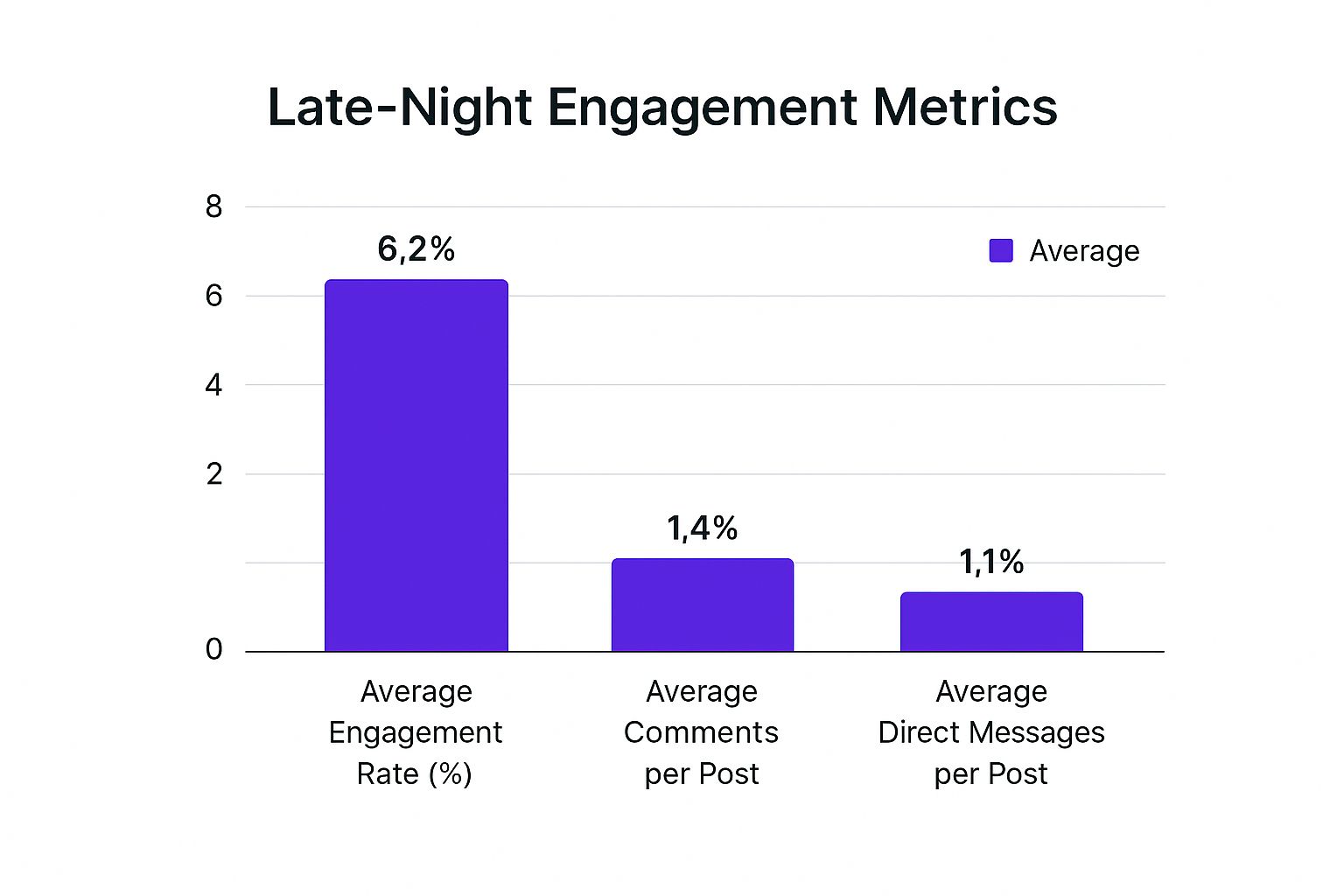
This data clearly illustrates that late-night users are more inclined to participate directly, as shown by the significant lifts in comments and direct messages.
Why This Window is So Effective
The success of the 9 PM to 11 PM window is rooted in audience psychology and modern media consumption habits. This is a prime time for entertainment and community-focused brands. Late-night talk shows like The Tonight Show Starring Jimmy Fallon have mastered this, using social media to share clips and interact with viewers in real time, driving conversation when their audience is most captive. The gaming industry also thrives here, with many streaming personalities and companies like Twitch and Riot Games seeing peak community interaction between 9 PM and 10 PM.
Streaming platforms provide another compelling case. A report by Netflix indicated that social media mentions and sharing activity for their original series often peak between 9 PM and 11 PM on release nights. B2C brands in fashion, food, and entertainment find this window particularly valuable. For instance, a popular DTC dessert brand reported a 35% increase in direct message inquiries about products after running interactive Instagram Stories and Q&As around 10 PM.
Expert Insight: "Late-night hours are community hours. The audience isn't just scrolling; they are seeking connection and entertainment. This is your chance to move beyond broadcasting and start a real conversation, building loyalty when your competitors have already signed off."
Actionable Tips for Late-Night Posts
To leverage this high-engagement, low-competition window, your content strategy must be tailored to the relaxed and interactive mindset of the late-night user.
- Prioritize Community and Conversation: This is the perfect time for interactive content. Use Instagram Stories with polls, quizzes, and "ask me anything" stickers. On X (formerly Twitter) or Facebook, run live Q&A sessions or host discussions related to trending topics or your niche.
- Focus on Entertaining or Personal Content: Users are looking to decompress. Share behind-the-scenes content, user-generated content, funny memes, or heartwarming stories. This humanizes your brand and builds a stronger emotional connection.
- Be Present for Real-Time Interaction: If you post at 10 PM, try to be online to respond to comments and messages as they come in. This immediate feedback validates your audience’s engagement and encourages more interaction, creating a vibrant community feel. Scheduling is good, but real-time engagement is better for this specific window.
7. Audience Analytics-Driven Timing
While general guidelines offer a fantastic starting point, the ultimate key to unlocking peak engagement is moving from broad industry advice to hyper-specific, data-driven decisions. This approach involves diving into your own platform analytics to discover the unique moments when your specific audience is most active and receptive. It’s about trading guesswork for concrete evidence, creating a posting schedule that is perfectly tailored to your followers’ behavior.
This strategy acknowledges that every audience is different. A community of night-owl gamers will have vastly different active hours than an audience of East Coast financial advisors. Relying solely on general best practices means you could be missing your brand's true sweet spot. Understanding the best times to post on social media for your account requires a commitment to analyzing your own performance data and letting your audience’s actions guide your content calendar.
Why This Window is So Effective
The power of analytics-driven timing lies in its precision. Instead of casting a wide net, you’re using a laser-focused approach validated by your own community's behavior. This method has been championed by performance marketing agencies and the analytics teams at major platforms like Meta and LinkedIn because it consistently delivers superior results. It’s a direct response to your followers’ digital habits.
For example, the beauty brand Glossier famously used Instagram Insights to discover its core audience of millennial and Gen Z consumers were most engaged around 2 PM EST, a non-traditional peak time that general guides might miss. Similarly, Patagonia's data team found through Facebook analytics that their posts about weekend adventures received 40% higher engagement when published on Saturday and Sunday mornings, directly aligning with when their audience was planning or embarking on outdoor activities. A local coffee shop might even find its peak is 11 AM on weekdays, when customers are looking for a midday caffeine boost.
Expert Insight: "Your analytics are your audience telling you exactly when they want to hear from you. Ignoring this data is like ignoring a customer who is standing at your front counter. It’s the most direct feedback you can get."
Actionable Tips for Analytics-Driven Posts
To effectively leverage your own data, you must adopt a systematic and consistent approach to reviewing and acting on your platform insights.
- Conduct Monthly Analytics Reviews: Set a recurring calendar reminder to dive into your Instagram Insights, Facebook Analytics, TikTok Analytics, or LinkedIn Page Analytics. Look for the "Most Active Times" charts and note any consistent patterns in the days and hours your followers are online.
- Use A/B Testing to Validate Insights: Once you identify a potential peak time from your analytics, test it. If your data suggests 8 PM is a strong window, schedule similar posts at 6 PM, 8 PM, and 10 PM on different days. Compare the reach, likes, and comments to confirm or refine your data-backed hypothesis.
- Account for Global Audiences: If your followers are spread across multiple time zones, your analytics may show broader active periods. Segment your audience or use scheduling tools that can post based on the user's location to ensure your content reaches everyone at their respective optimal times.
- Document and Iterate: Keep a simple spreadsheet or document tracking your posting times and the corresponding engagement metrics. Over time, this log will become an invaluable internal guide, revealing your brand’s unique and most effective posting windows.
Best Times to Post Comparison Guide
| Timing/Strategy | Implementation Complexity 🔄 | Resource Requirements ⚡ | Expected Outcomes 📊 | Ideal Use Cases 💡 | Key Advantages ⭐ |
|---|---|---|---|---|---|
| Morning Coffee Hours (6-9 AM) | Moderate (requires early scheduling) | Medium (content prep for professional audience) | High engagement, higher CTR for B2B | Professional, B2B content; working professionals | Fresh attention span; less competition |
| Lunch Break Window (12-2 PM) | Low (simple, consistent scheduling) | Low to Medium (focus on light, digestible content) | Moderate engagement, higher video views | Food, lifestyle, entertainment, viral content | Captures quick breaks; strong video performance |
| Evening Wind-Down (6-8 PM) | Moderate to High (content quality focus) | Medium to High (longer-form videos, stories) | High engagement, conversion rates | Lifestyle, ecommerce, storytelling content | Deeper engagement; strong across platforms |
| Weekend Prime Time (1-3 PM Sat/Sun) | Moderate (weekend scheduling and prep) | Medium (high-quality visuals and inspirational content) | High engagement; longer sessions | Lifestyle, personal interest, visual brands | Relaxed audience; higher shares and saves |
| Tue-Thu Sweet Spot (10 AM-3 PM) | Moderate (consistent mid-week output) | Medium (educational and B2B content) | Stable, predictable engagement | B2B, professional announcements, product launches | Consistent performance; optimal for business |
| Late Night Engagement (9-11 PM) | High (evening management, real-time monitoring) | Medium to High (interactive, community-focused content) | High comment and DM rates | Community building, entertainment, live content | Deep engagement; strong for live interactions |
| Audience Analytics-Driven Timing | High (data analysis and continuous optimization) | High (access to analytics tools, continuous testing) | Most accurate and tailored results | All content types with unique audience behavior | Data-driven, maximizes ROI and relevance |
From Insight to Impact: Putting Your Timing Strategy into Action
We've journeyed through the most promising windows for social media engagement, from the early morning coffee scroll to the late-night wind-down. You now have a strategic map outlining the peak hours across platforms like Instagram, Facebook, LinkedIn, TikTok, and X (formerly Twitter). The data-backed time slots we've explored, including the Morning Coffee Hours (6-9 AM), the Lunch Break Window (12-2 PM), and the Weekend Prime Time, provide a powerful launchpad for your content strategy.
However, understanding the general best times to post on social media is just the first step. The true path to maximizing your reach, engagement, and impact lies in transforming this universal knowledge into a personalized, data-driven system. Think of these recommended times not as rigid rules, but as your initial, educated hypotheses in a continuous experiment.
Moving Beyond Generalizations: Your Actionable Roadmap
The most significant takeaway from this entire guide is a single, powerful principle: your own data is the ultimate source of truth. While industry benchmarks point you in the right direction, your specific audience, niche, and content style will create a unique engagement pattern. Your mission is to uncover that pattern and leverage it for consistent growth.
Here are the critical next steps to transition from insight to real-world impact:
- Establish Your Baseline: Choose two to three of the recommended time slots from this article that best align with your target audience. For the next two to four weeks, consistently post your content within these windows. This creates a baseline dataset from which you can draw initial conclusions.
- Dive Deep into Your Analytics: Once you have baseline data, it's time to become an analyst. Go directly into the native analytics tools on each social media platform. Look for the "Audience" or "Insights" tabs and find the charts showing when your followers are most active. Compare these charts to your posting schedule. Are you posting when your audience is actually online?
Cross-Reference Performance with Timing: Don't just look at when your audience is online; look at when your posts perform best. Export your post data into a simple spreadsheet. Create columns for the post, the day of the week, the time of day, reach, likes, comments, and shares. You might discover that even though your audience is online at 8 PM, your educational carousels perform best at 7 AM when people are in a mindset to learn.
Pro Tip: Look for outliers. A post that dramatically over or under-performs is a valuable learning opportunity. Was it the time? The format? The topic? Dissecting these anomalies provides clues that averages can't.
The Evolution of Your Posting Strategy
Your posting schedule should be a living document, not a static one. Your audience's habits can shift due to seasonal changes, industry events, or global trends. A quarterly review of your posting schedule and its performance is essential to stay ahead.
Consider this workflow for ongoing optimization:
- Month 1: Test & Establish. Implement your baseline schedule based on the general best times to post.
- Month 2: Analyze & Refine. Review your native analytics and performance data. Identify your top two performing time slots and double down on them.
- Month 3: Experiment & Scale. With your core schedule locked in, use your other content slots to experiment with new times. Try posting 30 minutes earlier or an hour later. Test a late-night slot or an unconventional weekend morning time and see what happens.
Mastering your social media timing is a game of inches, but those inches add up to miles of growth. It elevates your strategy from "posting and praying" to a predictable system for connecting with your audience. By treating your timing as a dynamic and evolving strategy, you ensure your valuable content consistently lands in front of the right people at the exact moment they are ready to engage. This is how you build a powerful brand, cultivate a loyal community, and achieve your professional goals.
Ready to take the guesswork out of your social media timing and put your content strategy on autopilot? MakerBox uses AI to analyze your content and audience, scheduling your posts for peak engagement automatically. Stop guessing and start growing by visiting MakerBox to see how you can transform your social media workflow today.
